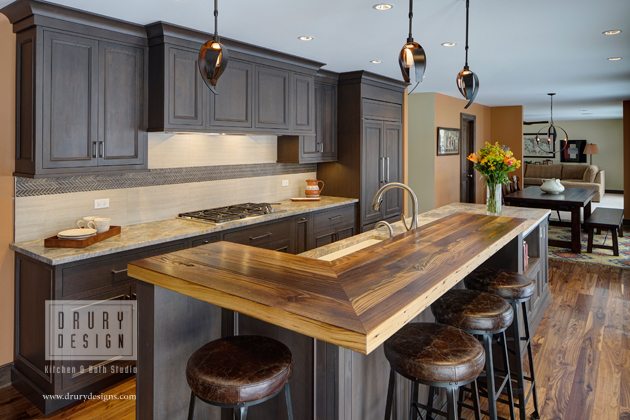The Warmth of Wood Countertops in Kitchens
Countertops are one of the most important features of your kitchen. After all, you live and work with your design choice all day, every day. And nothing is more satisfying than watching your guests feel right at home as they cozy up to your countertop for wine, appetizers and great conversation.
Wood countertops are a cozy addition to any kitchen due to their natural appearance, distinct color schemes, and detailed grains. They also act as a nice accent to any hardwood floors or cabinetry system in the house. Though they usually have an authentic antique feel, they’re also sleek and elegant to match any modern design. So obviously they look warm and inviting, but they also serve as a more practical kitchen tool than most other surface materials.
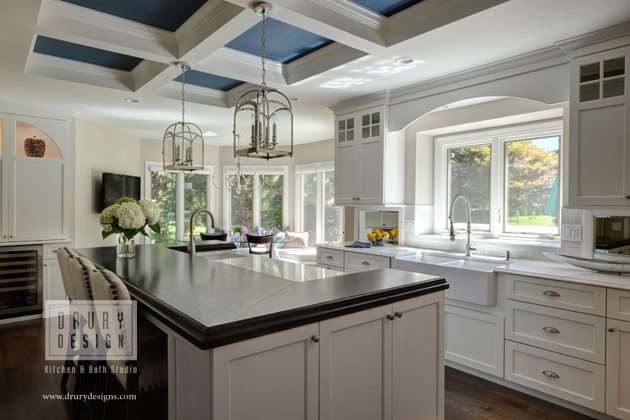
When selecting a material, durability, color, maintenance and function all play a significant role. Though granite, solid surfacing and marble are still widely used and valued for their remarkable qualities, the warmth of wood surfacing is, once again, becoming popular.
After being eclipsed by the showy stones like granite and marble and maintenance-free engineered materials like quartz and solid surfacing, natural-wood countertops are enjoying a real revival. Constructed from pieces of hardwood laminated together with glue for strength and stability, they provide a warm, organic landing surface in a kitchen, one that is wonderfully forgiving, gentle on dishware, and able to absorb the noise of a busy household. Wood can also be revived if damaged; if it gets dinged, stained, or gouged, you can refinish it.
Wood is beautiful. A custom butcher block countertop is a show stopper. It provides a wow factor that few other materials offer. Additionally, wood is highly customizable and can complement a range of design styles. It instantly adds a welcoming warmth to any room.
Work with All Design Styles: Wood counters go well with all styles including traditional, transitional, and modern.
Warmth: Not only is wood warm in appearance, it’s literally warmer to the touch than many materials such as tile, stone or concrete.
Recycled/Recyclable: Most wood countertops are not made from reclaimed wood, but that is changing. Wood is being salvaged and re-purposed for green countertops at a growing rate. Most wood countertops are recyclable. Unlike granite, wood is a renewable resource. Trees grow back, forests can be repopulated
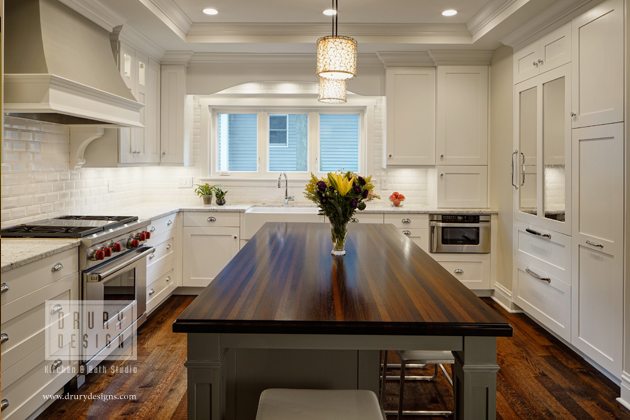
Like real stone, the natural imperfections in wood countertops add character. And some wood tops, like wood cabinetry, will age and develop a warm patina over time (cherry is a great example of this). If you like the warmth and character that wood styling brings to the overall design of your kitchen space, then this option is an ideal choice. When designing your kitchen, what better way to create a striking transitional masterpiece than to include the traditional warmth of a wood countertop in your contemporary space.
There are many types of wood countertops from which to choose. Hardwood continues to be used extensively. Wood types include maple, cherry, oak, birch and teak. Bamboo is a grass, but offers a wood-like appearance. Stains and finishes complete the look, giving each one a customized appearance. Stylistically, your options include butcher black, parquet, face grain or end grain planks, panels and other designs. Edge treatments are also made in a wide variety of looks.
Even though they’re all constructed in a similar fashion, there are also several different ways to configure them depending on the type of wood you choose. Here are two different compositions to choose from:
-
Edge Grain: This is when strips of wood are placed length-wise and edge to edge, forming longer, sleeker surfaces. Commonly used for most any traditional countertop, this construction looks smooth and beautiful in any kitchen.
-
End Grain: Often used in butcher blocks or islands, this construction uses short blocks of wood arranged so that the ends point up, revealing their growth rings. These wood counters are typically thicker, form a checker-board pattern, and are more durable. In fact, when using a knife against this surface, the blade isn’t even dulled because it squeezes between the grain instead of against it.
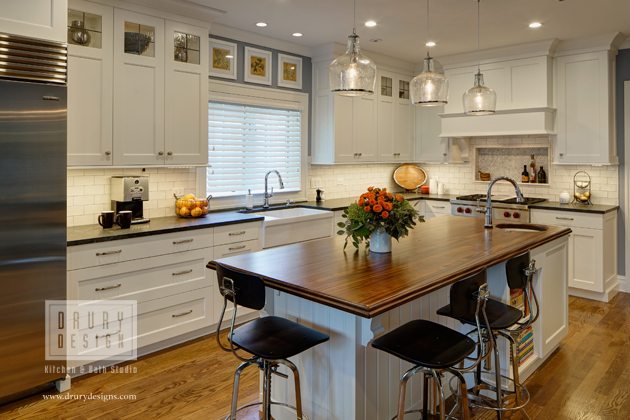
There have been many opinions regarding the microbial aspects of wood over the years, too. One urban legend on this topic holds that wood harbors a great deal of bacteria. The real truth is that the healing enzymes in trees kill off bacteria within 36 hours, even after the tree has been felled. Does this mean you should cut raw chicken or beef on it? Probably not, but warm water and soap are all that’s needed to maintain this material.
Let me assure you that wood countertops are not only easy to sanitize they naturally kill bacteria too. Germs like salmonella and the norovirus aren’t going to take root in your kitchen work surface and make you sick unless you neglect them.
This is one of the biggest concerns, but by keeping them clean and occasionally disinfecting them you’ll have perfectly hygienic countertops.
-
Keep countertops clean with a mild soap and water.
-
Follow manufacturer advice on maintaining their specific finish.
-
Don’t allow wood tops to soak with water or other liquids.
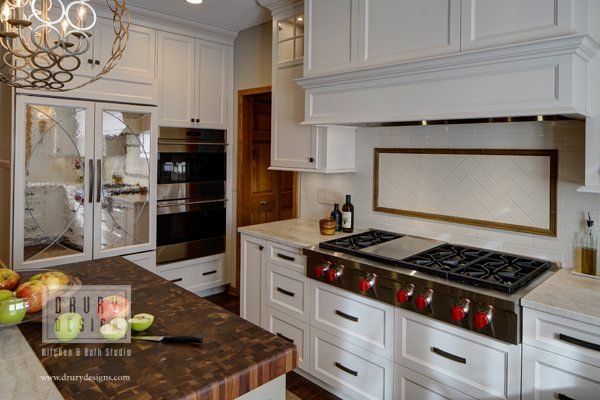
Cutting on wood surfacing is another big question when considering this design option in the kitchen. Know that wood will dent and scratch, so if you’re okay with the worn cutting board look, go for it. If not, I would use a separate cutting board on top of the wood. One practical suggestion is to designate a part of your island as a cutting board area, which allows you to maintain the flawless integrity of the remaining countertop. It is also recommended that only soap and water be used to clean wood countertops. No harsh chemicals should touch this material.
IS SEALING REQUIRED?
Yes, you must seal butcher block countertops regularly to keep them from absorbing water. You have multiple options, and which one you choose depends on how you plan to use the counter.
Good advice: Research your wood surfacing options to make sure they fit your lifestyle. As long as you know how this material reacts, you can make a value judgment as to whether wood will function well for your family.
Things to Remember about Wood Countertops:
-
These countertops present a warm, natural surface.
-
Wood may be a renewable, sustainable material — if “green” practices are followed by the harvester or the wood is recycled.
-
Beautiful patterns and designs are available depending on the species of wood and its grain.
-
Stains and finishes can create a wider range of design choices. (For example, a checkerboard pattern can be chosen for a butcher block countertop).
-
Wood provides a solid work surface for food preparation, depending on grain orientation.
-
Wood countertops are great for kneading bread dough or rolling piecrust.
-
They won’t easily damage your dinnerware.
-
These countertops tend to look even more beautiful with age and use.
Are Wood Countertops Right for Your Home?
This depends on the look and feel you want in your home, and to a lesser extent, how much effort you’re willing to put into maintaining your wood countertop. Butcher block countertops are stunning. If you want the natural beauty of wood and are willing to spend a minimal amount of effort cleaning and maintaining your investment, then a wood countertop will be a great addition to your home for many years to come. A butcher block countertop can transform a kitchen into a work of art – and properly cared for, will outlast the home.
For more kitchen design ideas, check out our portfolio.

